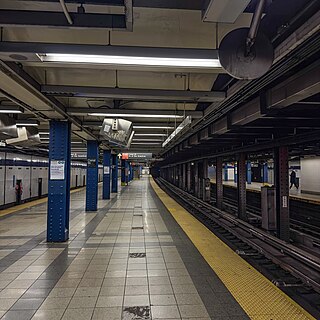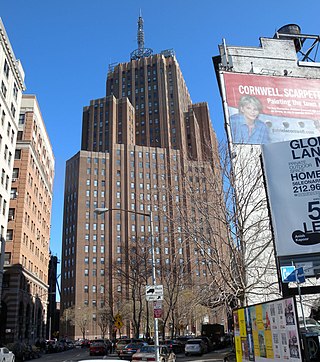
Tribeca, originally written as TriBeCa, is a neighborhood in Lower Manhattan in New York City. Its name is a syllabic abbreviation of "Triangle Below Canal Street". The "triangle" is bounded by Canal Street, West Street, Broadway, and Chambers Street. By the 2010s, a common marketing tactic was to extend Tribeca's southern boundary to either Vesey or Murray Streets to increase the appeal of property listings.

Mr. Peanut is the advertising logo and mascot of Planters, an American snack-food company owned by Hormel. He is depicted as an anthropomorphic peanut in its shell, wearing the formal clothing of an old-fashioned gentleman, with a top hat, monocle, white gloves, spats, and cane. He is reported of British heritage and has the proper name of Bartholomew Richard Fitzgerald-Smythe.

The 174th Street station is a local station on the IRT White Plains Road Line of the New York City Subway. Located at the intersection of 174th Street, Southern Boulevard & Boston Road in the Crotona Park East neighborhood of the Bronx, it is served by the 2 train at all times, and the 5 train at all times except late nights and rush hours in the peak direction.

The West Farms Square–East Tremont Avenue station is a local station on the IRT White Plains Road Line of the New York City Subway. Located at the intersection of East Tremont Avenue and Boston Road in the West Farms neighborhood of the Bronx, it is served by the 2 train at all times, and the 5 train at all times except late nights and rush hours in the peak direction.

The Cross Bronx Expressway is a major freeway in the New York City borough of the Bronx. It is mainly designated as part of Interstate 95 (I-95), but also includes portions of I-295 and U.S. Route 1 (US 1). The Cross Bronx begins at the Alexander Hamilton Bridge over the Harlem River, where the Trans-Manhattan Expressway continues west across Upper Manhattan to the George Washington Bridge. While I-95 leaves at the Bruckner Interchange in Throgs Neck, following the Bruckner Expressway and New England Thruway to Connecticut, the Cross Bronx Expressway continues east, carrying I-295 to the merge with the Throgs Neck Expressway near the Throgs Neck Bridge. Though the road goes primarily northwest-to-southeast, the nominal directions of all route numbers west of the Bruckner Interchange are aligned with the northbound route number going southeast, and the southbound route number going northwest.

The Canal Street station is an express station on the IND Eighth Avenue Line of the New York City Subway. Located at the intersection of Canal Street, Vestry Street, and Sixth Avenue in Lower Manhattan, it is served by the A and E trains at all times, and the C train at all times except late nights.

The Canal Street station is a local station on the IRT Broadway–Seventh Avenue Line of the New York City Subway, located in Lower Manhattan at the intersection of Canal and Varick Streets. It is served by the 1 train at all times and by the 2 train during late nights.

The Houston Street station is a local station on the IRT Broadway–Seventh Avenue Line of the New York City Subway. Located at West Houston and Varick Streets in Greenwich Village, Manhattan, it is served by the 1 train at all times and by the 2 train during late nights.

The Christopher Street–Sheridan Square station is a local station on the IRT Broadway–Seventh Avenue Line of the New York City Subway. Located at the intersection of Christopher Street and Seventh Avenue South in Manhattan, it is served by the 1 train at all times and by the 2 train during late nights.

Crotona Park is a public park in the South Bronx in New York City, covering 127.5 acres (51.6 ha). The park is bounded by streets of the same name on its northern, eastern, southern, and western borders, and is adjacent to the Crotona Park East and Morrisania neighborhoods of the Bronx. It is divided into four portions by Claremont Parkway and Crotona Avenue, which run through it.

60 Hudson Street, formerly known as the Western Union Building, is a 24-story telecommunications building in the Tribeca neighborhood of Manhattan in New York City. Built in 1928–1930, it was one of several Art Deco-style buildings designed by Ralph Thomas Walker of Voorhees, Gmelin and Walker for telecommunications in the early 20th century. 60 Hudson Street spans the entire block between Hudson Street, Thomas Street, Worth Street, and West Broadway.

108 Leonard, formerly known as 346 Broadway, the New York Life Insurance Company Building, and the Clock Tower Building, is a residential structure in the Tribeca neighborhood of Manhattan in New York City, United States. Built from 1894 to 1898, the building was constructed for the New York Life Insurance Company. Stephen Decatur Hatch created the original plans while McKim, Mead & White oversaw the building's completion. The building occupies a city block bounded by Broadway to the west, Leonard Street to the north, Lafayette Street to the east, and Catherine Lane to the south. It is a New York City designated landmark and is listed on the National Register of Historic Places.

101 Warren Street is a 35-story apartment building in the Tribeca neighborhood of Lower Manhattan, New York City, between Greenwich Street and West Street. The project was developed by Edward J. Minskoff Equities, designed by Skidmore Owings & Merrill, and completed in 2008. It consists of 227 condominiums and 163 rental units.

32 Avenue of the Americas is a 27-story, 549-foot-tall (167 m) telecommunications building in the Tribeca neighborhood of Manhattan in New York City. Completed in 1932, it was one of several Art Deco-style telecommunications buildings designed by Ralph Thomas Walker of Voorhees, Gmelin and Walker in the early 20th century. 32 Avenue of the Americas spans the entire block bounded by Walker Street, Lispenard Street, Church Street, and Avenue of the Americas.

Bronx Terminal Market, formerly known as Gateway Center at Bronx Terminal Market, is a shopping mall along the Major Deegan Expressway in Concourse, Bronx, New York. The center encompasses just under one million square feet of retail space built on a 17-acre (69,000 m2) site that formerly held a wholesale fruit and vegetable market as well as the former Bronx House of Detention, south of Yankee Stadium.

The Cunard Building, formerly the Standard & Poors Building, is a 22-story office building at 25 Broadway, across from Bowling Green Park, in the Financial District of Lower Manhattan in New York City. The Cunard Building was designed in the Italian Renaissance style by Benjamin Wistar Morris, in conjunction with consultants Carrère & Hastings. The Cunard Building's facade and principal first-floor interior spaces are New York City designated landmarks, and the building is also a contributing property to the Wall Street Historic District, a National Register of Historic Places district created in 2007.

The Mutual Reserve Building, also known as the Langdon Building and 305 Broadway, is an office building at Broadway and Duane Street in the Tribeca neighborhood of Manhattan in New York City. The 13-story building, constructed between 1892 and 1894, was designed by William H. Hume and built by Richard Deeves, with Frederick H. Kindl as chief structural engineer. It is just east of the Civic Center of Manhattan, and carries the addresses 305–309 Broadway and 91–99 Duane Street.

The Greenwich Savings Bank Building, also known as the Haier Building and 1356 Broadway, is an office building at 1352–1362 Broadway in the Midtown Manhattan neighborhood of New York City. Constructed as the headquarters of the Greenwich Savings Bank from 1922 to 1924, it occupies a trapezoidal parcel bounded by 36th Street to the south, Sixth Avenue to the east, and Broadway to the west. The Greenwich Savings Bank Building was designed in the Classical Revival style by York and Sawyer.

Fleetwood Park was a 19th-century harness racing track in what is now the Morrisania section of the Bronx in New York, United States. The races were a popular form of entertainment, drawing crowds as large as 10,000 spectators, who would come from Manhattan and Brooklyn. One travel guide described the 1-mile course as "the most famous trotting track in the country".






















